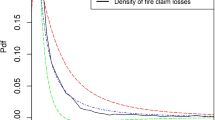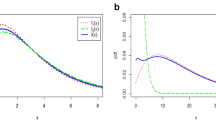Abstract
In this paper, extreme behaviors of a mixture distribution are analyzed. We investigate some cases where the mixture distributions are in the proper domain of attraction so that the extreme value of mixture distributions converges to the proper Generalized Extreme Value distribution (GEV). However, in general, there is no guarantee that the distribution of the data is in the proper maximum domain of attraction. Furthermore, since the convergence rate can be slow even with guaranteed asymptotic convergence, GEV estimation method might provide a biased estimation, as shown in Choi et al. (2014). The paper provides a safe method to control the quality of the quantile estimator in extreme values.
Similar content being viewed by others
References
Akpinar, S., & Akpinar, E. K. (2009). Estimation of wind energy potential using finite mixture distribution models. Energy Conversion and Management, 50(4), 877–884.
Choi, Y., Gwak, W., Goo, H., & Ahn, J. Y. (2014). Statistical estimation of extreme values in the mixture distributions. The Journal of Risk Management, 25(3), 31–56.
Coles, S. (2001). Springer series in statistics, An introduction to statistical modeling of extreme values. London: Springer-Verlag London, Ltd..
Embrechts, P., Klüppelberg, C., & Mikosch, T. (1997). Applications of mathematics (New York): Vol. 33. Modelling extremal events. Berlin: Springer-Verlag, For insurance and finance.
Jaramillo, O., & Borja, M. (2004). Wind speed analysis in la ventosa, mexico: a bimodal probability distribution case. Renewable Energy, 29(10), 613–630.
Klugman, S. A., Panjer, H. H., & Willmot, G. E. (2008). Wiley series in probability and statistics, Loss models (third ed.). Hoboken, NJ: John Wiley & Sons, Inc., From data to decisions.
Kollu, R., Rayapudi, S. R., Narasimham, S., & Pakkurthi, K. M. (2012). Mixture probability distribution functions to model wind speed distributions. International Journal of Energy and Environmental Engineering, 3.
Morrison, J. E., & Smith, J. A. (2002). Stochastic modeling of flood peaks using the generalized extreme value distribution. Water Resources Research, 38(12), 41–41.
R Core Team. (2013). R: A Language and Environment for Statistical Computing. R Foundation for Statistical Computing, Vienna, Austria.
Silverman, B. W. (1986). Monographs on statistics and applied probability, Density estimation for statistics and data analysis. London: Chapman & Hall.
Smith, R. L. (1985). Maximum likelihood estimation in a class of nonregular cases. Biometrika, 72(1), 67–90.
Tian Pau, C. (2011). Estimation of wind energy potential using different probability density functions. Applied Energy, 88(5), 1848–1856.
van der Vaart, A. W. (1998). Cambridge series in statistical and probabilistic mathematics: Vol. 3. Asymptotic statistics. Cambridge: Cambridge University Press.
Author information
Authors and Affiliations
Corresponding author
Additional information
Co-first Author.
Rights and permissions
About this article
Cite this article
Gwak, W., Goo, H., Choi, Y.H. et al. Extreme value theory in mixture distributions and a statistical method to control the possible bias. J. Korean Stat. Soc. 45, 581–594 (2016). https://doi.org/10.1016/j.jkss.2016.04.003
Received:
Accepted:
Published:
Issue Date:
DOI: https://doi.org/10.1016/j.jkss.2016.04.003




